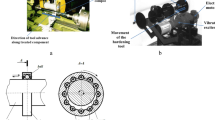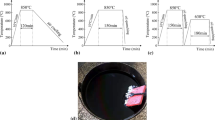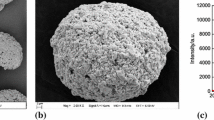Abstract
A 40Cr steel was formed into a chain-wheel using a warm extrusion technology. The surface roughness and micro-structure, micro-hardness and phases of the extruded samples at different temperatures were analyzed using a three-dimensional optical microscope (OM), micro-hardness tester, and X-ray diffraction (XRD), respectively. The morphologies, chemical element distributions and phases of worn tracks at the extrusion temperatures of 550, 650 and 750 °C were analyzed using a scanning electron microscopy (SEM), energy disperse spectroscopy (EDS), and XRD, respectively. The friction-wear behaviors of extruded samples under oil-lubrication condition were observed using a wear test. And the effects of extrusion temperatures on the wear mechanism were discussed. The results show that residual austenite and pearlite exist on the sample at the extrusion temperature of 550 °C with the corresponding grain size and surface micro-hardness of 32.7 nm and 370.33 HV, respectively. The average coefficient of friction (COF) of extruded sample at the temperature of 550 °C is 0.196 5, and the wear mechanism is fatigue and abrasive wear. While the acicular martensite exists on the extruded samples at the extrusion temperatures of 650 and 750 °C, the corresponding grain sizes are 30.0 and 29.1 nm, respectively. The average COF (coefficient of friction) of extruded sample at the temperatures of 650 and 750 °C are 0.187 4 and 0.163 6, respectively, and the wear mechanism is abrasive wear. As a result, the friction performance of extruded sample at the temperatures of 650 and 750 °C is better than that at the temperature of 550 °C.
Similar content being viewed by others
References
Zhang W, Yao J H. Surface Laser Alloying and Its Application on 40Cr Steel Screw[J]. J. Heat Treat Metals, 2007, 32(11): 59–61
Qiu M S, Ji C, Zhu M Y, et al. Effect of Cooling Rate and Austenitizing Temperature on the Spheroidizing Annealing of 40Cr Steel[J]. J. Chin. J. Eng., 2015, 37(9): 1 143–1 148
Wu A Q, Liu Q B, Qin S J. Influence of Yttrium on Laser Surface Alloying Organization of 40Cr Steel[J]. J. Rare Earths, 2011, 29(10): 1 004–1 008
Dong H G, Yu L Z, Deng D W. Effect of Post-weld Heat Treatment on Properties of Friction Welded Joint between TC4 Titanium Alloy and 40Cr Steel Rods[J]. J. Mater. Sci. Technol., 2015, 31(9): 962–968
Ge Y C, Yi M Z, Li L Y. Influence of Load on Sliding Tribology of C/C Composite with 40Cr Steel Couple Coated by Cr[J]. J. Trans Nonferrous Met. Soc. China, 2007, 17(3): 570–574
Dong H G, Yu L Z, Gao H M. Microstructure and Mechanical Properties of Friction Welds between TiAl Alloy and 40Cr Steel Rods[J]. J. Trans. Nonferrous Met. Soc. China, 2014, 24(10): 3 126–3 133
Li Y F, Pan X D, Wang G L. Low Cycle Fatigue and Ratcheting Properties of Steel 40Cr under Stress Controlled Tests[J]. J. Int J Fatigue, 2013, 55: 74–80
Wu L Z, Chen J, Zhang H B. Dynamic Recrystallization of Austenite and Grain Refinement in 40Cr Steel[J]. J. Shanghai Jiaotong U., 2008, 42(5): 786–790
Niu C S, Huang X F, Wang Y L, et al. Warm Extrusion Process of Fe-Si System Alloys[J]. J. Univ. Sci. Technol. Beijing., 2006, 28(7): 641–644
Zhou Y X, Pang Z G, Li Y Q, et al. Study on Lubricants and Cooling Method for Warm Extrusion[J]. J. Forging and Stamping Technology, 2009, 34(3): 6–9
Li Y Y, Zhao S D, Fan S Q, et al. Study on the Material Characteristic and Process Parameters of the Open-die Warm Extrusion Process of Spline Shaft with 42CrMo Steel[J]. J. Alloys Compds., 2013, 571: 12–20
Wang J Q, Dong P, Hou W L, et al. Synthesis of Al-rich Bulk Metallic Glass Composites by Warm Extrusion of Gas Atomized Powders[J]. J. Alloys Compds., 2013, 554: 419–425
Onawola O O, Adeyemi M B. Warm Compression and Extrusion Tests of Aluminums[J]. J. Mater. Process Technol., 2003, 136(1–3): 7–11
Eghbali B, Shaban M. Warm Deformation of Low Carbon Steel Using forward Extrusion-equal Channel Angular Pressing Technique[J]. J. Iron Steel Res. Int., 2013, 20(2): 68–71
Hun H J. A Three-dimensional Finite Element Simulation of the Warm Extrusion of AZ31 Alloy Billets[J]. J. Manuf Processes, 2010, 12(2): 67–72
Chen H H, Ren J, Du F, et al. Friction and Wear Behaviour of In-situ Transformed Cf/Al2O3 Composite under Different Lubrication Conditions[J]. J. Wear., 2015, 332–333: 918–925
Hu X P, Zhang H A, Yan J H, et al. Friction and Wear Properties of MoSi2 under Oil Lubrication[J]. J. Chinese Jou. Mec. Eng., 2006, 17(15): 1 630–1 634
Author information
Authors and Affiliations
Corresponding author
Additional information
Funded by Jiangsu Province Science and Technology Support Program (Industry) (No. BE2014818) and the Research Project of Scientific Research Innovation for Graduate Students of Jiangsu Province (No. KYLX16-0631)
Rights and permissions
About this article
Cite this article
Chen, H., Liu, W. & Kong, D. Effect of Extrusion Temperatures on Friction-wear Behavior of Chain-wheel Fabricated by 40Cr Steel under Oil-lubrication Condition. J. Wuhan Univ. Technol.-Mat. Sci. Edit. 34, 684–691 (2019). https://doi.org/10.1007/s11595-019-2104-0
Received:
Accepted:
Published:
Issue Date:
DOI: https://doi.org/10.1007/s11595-019-2104-0




